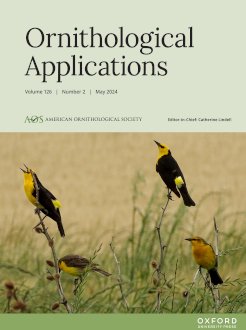Wetlands of the Laurentian Great Lakes of North America (i.e., lakes Superior, Michigan, Huron, Erie, and Ontario) provide critical habitat for marsh birds. We used 11 years (2011–2021) of data collected by the Great Lakes Coastal Wetland Monitoring Program at 1,962 point-count locations in 792 wetlands to quantify the first-ever annual abundance indices and trends of 18 marsh-breeding bird species in coastal wetlands throughout the entire Great Lakes. Nine species (50%) increased by 8–37% per year across all of the Great Lakes combined, whereas none decreased. Twelve species (67%) increased by 5–50% per year in at least 1 of the 5 Great Lakes, whereas only 3 species (17%) decreased by 2–10% per year in at least 1 of the lakes. There were more positive trends among lakes and species (n = 34, 48%) than negative trends (n = 5, 7%). These large increases are welcomed because most of the species are of conservation concern in the Great Lakes. Trends were likely caused by long-term, cyclical fluctuations in Great Lakes water levels. Lake levels increased over most of the study, which inundated vegetation and increased open water-vegetation interspersion and open water extent, all of which are known to positively influence abundance of most of the increasing species and negatively influence abundance of all of the decreasing species. Coastal wetlands may be more important for marsh birds than once thought if they provide high-lake-level-induced population pulses for species of conservation concern. Coastal wetland protection and restoration are of utmost importance to safeguard this process. Future climate projections show increases in lake levels over the coming decades, which will cause “coastal squeeze” of many wetlands if they are unable to migrate landward fast enough to keep pace. If this happens, less habitat will be available to support periodic pulses in marsh bird abundance, which appear to be important for regional population dynamics. Actions that allow landward migration of coastal wetlands during increasing lake levels by removing or preventing barriers to movement, such as shoreline hardening, will be useful for maintaining marsh bird breeding habitat in the Great Lakes.
LAY SUMMARY
We calculated the first-ever abundance estimates for 18 marsh-breeding bird species over 11 years (2011–2021) in coastal wetlands throughout all of the North American Great Lakes.
Abundance of 9 (50%) species increased by large amounts, but none decreased, which is welcomed because the abundance of most species was already low.
Increases were likely caused by rising water levels, which created high-quality marsh bird habitat consisting of patches of wet, standing vegetation (such as cattails) interspersed with pools of open water.
Coastal wetlands may provide critical, periodic boosts to regional populations of marsh birds during rising water levels, but this may be threatened in the future because extremely high-water levels due to climate change could cause reductions in marsh bird habitat due to flooding.
Protection and restoration of coastal wetlands and actions that allow landward migration of coastal wetlands by removing or preventing barriers to movement will be needed.
Les zones humides des Grands Lacs laurentiens d'Amérique du Nord (c.-à-d. les lacs Supérieur, Michigan, Huron, Érié et Ontario) constituent un habitat essentiel pour les oiseaux de marais. Nous avons utilisé 11 ans (2011-2021) de données recueillies par le Programme de surveillance des zones humides côtières des Grands Lacs à 1 962 points d'écoute dans 792 zones humides pour quantifier les tout premiers indices annuels d'abondance et les tendances chez 18 espèces d'oiseaux de marais dans les zones humides côtières de l'ensemble des Grands Lacs. Neuf espèces (50 %) ont augmenté de 8 à 37 % par année dans l'ensemble des Grands Lacs, tandis qu'aucune n'a diminué. Douze espèces (67 %) ont augmenté de 5 à 50 % par année dans au moins un des cinq Grands Lacs, alors que seulement trois espèces (17 %) ont diminué de 2 à 10 % par année dans au moins un des lacs. Il y avait plus de tendances positives parmi les lacs et les espèces (n = 34, 48 %) que de tendances négatives (n = 5, 7 %). Ces fortes augmentations sont les bienvenues car la plupart des espèces sont préoccupantes sur le plan de la conservation dans les Grands Lacs. Les tendances ont probablement été causées par des fluctuations cycliques à long terme des niveaux d'eau des Grands Lacs. Le niveau des lacs a augmenté pendant la majeure partie de l'étude, ce qui a inondé la végétation et augmenté la juxtaposition de l'eau libre et de la végétation, ainsi que l'étendue de l'eau libre, qui sont reconnus pour influencer positivement l'abondance de la plupart des espèces en augmentation et d'influencer négativement l'abondance de toutes les espèces en diminution. Les zones humides côtières peuvent être plus importantes pour les oiseaux de marais qu'on ne le pensait auparavant si elles fournissent des impulsions démographiques induites par le niveau élevé des lacs pour les espèces dont la conservation est préoccupante. La protection et la restauration des zones humides côtières sont d'une importance capitale pour préserver ce processus. Les projections climatiques futures indiquent une augmentation des niveaux d'eau au cours des prochaines décennies, ce qui entraînera une « compression côtière» de plusieurs zones humides si elles ne sont pas en mesure de migrer vers l'intérieur des terres assez rapidement pour suivre le rythme. Dans ce cas, il y aura moins d'habitat disponible pour soutenir les pulsations périodiques de l'abondance des oiseaux de marais, qui semblent importantes pour la dynamique des populations régionales. Les mesures qui permettent la migration vers l'intérieur des terres des zones humides côtières lorsque le niveau des lacs augmente, en éliminant ou en empêchant la formation d'obstacles au mouvement, comme le durcissement des rives, seront utiles pour maintenir l'habitat de reproduction des oiseaux de marais dans les Grands Lacs.





